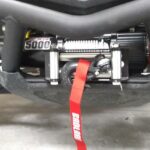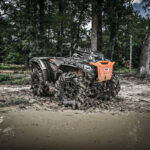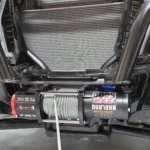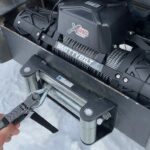In this article, we delve into the distinct characteristics and applications of Brake Winches and Worm Gear Winches. You’ll gain a clear understanding of how each type operates, their safety features, performance, and suitability for various tasks. Whether you’re deciding which winch to purchase for your needs or simply curious about their differences, this guide provides a comprehensive comparison to inform your choice.
Brake Winch vs Worm Gear - Comparison Table
| Aspect | Brake Winch | Worm Gear Winch |
| Safety | Automatic braking system ensures secure load holding, reducing accident risk. | Natural prevention of backdriving offers superior load security. |
| Ease of Use | Simpler to operate, user-friendly for a range of users including beginners. | Higher gear ratios offer precision but can be more complex to operate, especially under heavy loads. |
| Cost | More affordable, offering good value for light to medium-duty tasks. | Generally more expensive due to complex design and heavy-duty capabilities. |
| Performance | Suitable for light to medium loads; may not be as effective for heavy-duty tasks. | Ideal for heavy-duty performance, strong and durable for demanding applications. |
| Control | May not offer the same level of control in precise load management compared to worm gear winches. | High gear ratios allow for precise control over loads, essential for meticulous handling. |
| Maintenance | Braking system may require regular maintenance for safety and performance. | Typically longer lifespan with robust construction, but may require maintenance for heavy use. |
| Physical Effort | Generally requires less manual effort compared to worm gear winches. | Can require more manual effort, especially under heavy loads. |
| Speed | Faster operation compared to worm gear winches. | Slower operation due to high gear ratios, not suitable for tasks requiring quick winching. |
| Size and Weight | Often lighter and more compact, easier to install in various settings. | Heavier and bulkier, which might be a consideration for portability and installation space. |
Brake Winches
A brake winch, also known as a self-locking winch, is a type of winch that incorporates an automatic braking system[1]. This system engages as soon as the winching operation is stopped, preventing the load from moving or slipping.
The core mechanism involves a ratchet and pawl system. When the handle is turned, the ratchet rotates and moves the load. If the handle is released, the pawl engages with the ratchet teeth, locking it in place and securing the load.
Key Features
Automatic Braking Systems: The most significant feature of a brake winch is its built-in braking system, which ensures that the load remains stationary and secure when the winching operation is not active.

Safety Aspects: This type of winch is particularly safe to use as the automatic brake prevents accidental release or slippage of the load, reducing the risk of injuries or damage.
Load-Holding Capacity: Brake winches are excellent for holding loads in a fixed position for extended periods, making them ideal for applications where load stability is crucial.
Common Applications
Lifting and Lowering Operations: Often used in scenarios where precise control of the load’s movement is necessary, such as in construction, theater stage setups, and equipment installations.
Boating and Marine Uses: Suitable for lifting anchors or small boats where the automatic brake can provide additional safety.
General Purpose Lifting: Ideal for agricultural, industrial, and home use, especially in applications where the load needs to be held in place without continuous manual support.
Worm Gear Winches
Worm gear winches operate[2] using a worm gear arrangement, where a worm (screw) meshes with a worm gear (wheel) to move the load. This design allows for substantial load control and reduces the risk of backdrive, making it suitable for heavy-duty applications.
The mechanism works by turning the worm, which in turn rotates the worm gear. This action either spools or unspools the cable, thereby lifting or lowering the load.
Key Features
Gear Ratios: Worm gear winches typically have high gear ratios, meaning a high number of turns of the worm is required to rotate the worm gear by a single revolution. This results in precise control but slower operation.
Load Security: The inherent design of worm gears, where the worm usually cannot be driven by the worm gear, provides a natural braking mechanism. This ensures that the load remains stable and secure, even without an external braking system.
Speed of Operation: Due to their gear ratios, these winches are generally slower compared to other types, making them less suitable for rapid lifting or pulling but excellent for controlled, heavy lifting.
Common Applications
Industrial Lifting and Pulling: Commonly used in construction, manufacturing, and heavy equipment handling due to their strength and reliability.
Off-road and Recovery Operations: Their ability to handle heavy loads with precision makes them a favorite in off-road vehicle recovery scenarios.
Theater and Stage Rigging: The precise control offered by worm gear winches is ideal for managing stage setups, where controlled movement of scenery and equipment is crucial.
Comparing Brake Winch and Worm Gear Winch
Now we’ll explore the key differences between brake winches and worm gear winches, helping you understand their distinct characteristics and ideal applications.
Performance
Brake Winches: Known for their safety and reliability, brake winches provide a secure hold when the winching operation is halted. They are suitable for various lifting and lowering tasks but may not offer the same level of heavy-duty performance as worm gear winches.

Worm Gear Winches: These winches excel in heavy-duty applications due to their robust design and high gear ratios. They offer precise control over heavy loads, albeit at a slower operation speed compared to brake winches.
Safety Features
Brake Winches: The automatic braking system is a standout safety feature, ensuring the load is securely held in place when the winching operation is stopped. This reduces the risk of accidental release or slippage.
Worm Gear Winches: The natural braking mechanism provided by the worm gear design offers a high level of load security. This makes them exceptionally safe for heavy loads, as the gear arrangement prevents the winch from backdriving.
Ease of Use
Brake Winches: Generally user-friendly, these winches are easier to operate and maintain. Their automatic braking system simplifies the process, making them suitable for a wide range of users.
Worm Gear Winches: While offering greater control, they can be more complex to operate due to their slower speed and higher gear ratios. They may require more effort to turn, especially under heavy loads.
Durability and Reliability
Brake Winches: Typically durable and reliable for medium-duty tasks.
However, the longevity can be influenced by the quality of the braking system and the conditions of use.

Worm Gear Winches: Known for their robust construction, these winches are often more durable and suited for continuous heavy-duty use. Their design minimizes wear and tear, enhancing their lifespan.
Cost
Brake Winches: Generally more cost-effective, making them a popular choice for budget-conscious users who need a reliable winch for light to medium applications.
Worm Gear Winches: Tend to be more expensive due to their complex design and heavy-duty capabilities. However, the investment can be justified by their strength, precision, and durability.
In summary, while both brake winches and worm gear winches have their unique advantages, the choice between them largely depends on the specific requirements of the task, including load size, safety considerations, frequency of use, and budget constraints.
Choosing the Right Winch for Your Needs
When selecting between a brake winch and a worm gear winch, consider the following factors to ensure you choose the right equipment for your specific needs:
Load Size and Weight: Assess the typical weight and size of the loads you’ll be handling. If you’re dealing with heavy-duty tasks, a worm gear winch might be more suitable. For lighter loads, a brake winch could suffice.
Frequency of Use: Consider how often you’ll be using the winch. For frequent, heavy use, a durable worm gear winch is advisable. For occasional or light use, a brake winch may be more practical.
Safety Requirements: If your primary concern is safety, especially in unattended or high-risk situations, a brake winch with its automatic braking system offers added security.
Precision and Control: For tasks requiring meticulous control over the load, such as in theater settings or delicate lifting operations, the precise control offered by worm gear winches is beneficial.
Budget Constraints: Brake winches are generally more cost-effective, making them a good choice for budget-conscious buyers. Worm gear winches, while more expensive, offer value for money in heavy-duty and high-precision applications.
Environmental Conditions: Consider the environment in which the winch will be used. If it’s likely to face harsh conditions, the robustness of a worm gear winch might be more appropriate.
Space and Portability: Evaluate the space where the winch will be installed. Brake winches are often more compact, while worm gear winches might require more room.
Final Thoughts
A brake winch is an excellent choice for general-purpose use, offering safety and ease of use, particularly in lighter applications. On the other hand, a worm gear winch, with its superior load control and durability, is better suited for heavy-duty tasks and applications where precision is key.
A brake winch is an excellent choice for general-purpose use, offering safety and ease of use, particularly in lighter applications. On the other hand, a worm gear winch, with its superior load control and durability, is better suited for heavy-duty tasks and applications where precision is key.
References
Hagemeister Enterprises, INC. (2019, March 6). Winch motors understanding the braking system [Video]. YouTube. https://www.youtube.com/watch?v=wYEsa7pi1i0
Mohammad Shafinul Haque. (2020, June 21). Worm Gear (Worm Drive): What is it, How it works, why huge velocity ratio and mechanical advantage? [Video]. YouTube. https://www.youtube.com/watch?v=pfRFXhXQRgA


![Badland vs Rough Country Winch - Pull Capacity, Price, Warranty, Build Quality [Everything Revealed]](https://drwinch.com/wp-content/uploads/2024/03/Badland-vs-Rough-Country-Winch-Pull-Capacity-Price-Warranty-Build-Quality-Everything-Revealed-150x150.jpeg)





